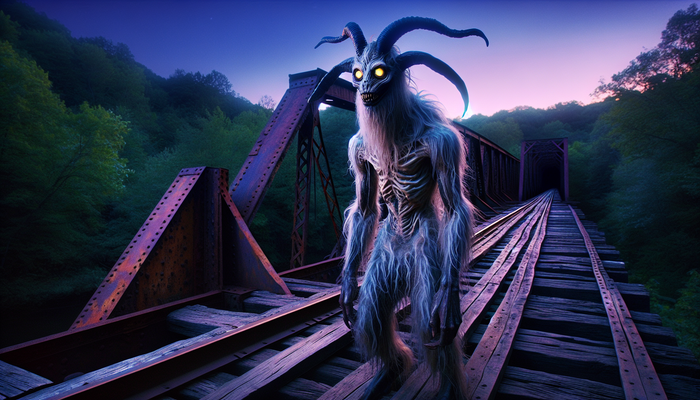Sasquatch's Elaborate Forest Nests

By Ava Martinez, Bigfoot Researcher and Teacher
The Enduring Mystery of Bigfoot
For centuries, tales of a large, hairy, humanoid creature roaming the remote forests of North America have captured our collective imagination. Known by many names - Sasquatch, Bigfoot, Skookum - this elusive beast has become a cultural icon, spawning countless expeditions, investigations, and pop culture references. Despite decades of searching, definitive proof of Bigfoot's existence remains frustratingly out of reach. Footprint casts, blurry photos, and eyewitness accounts tantalize us with the possibility that there may be an undiscovered primate species lurking in our midst, but skeptics argue that the evidence is far from conclusive.
Amidst the ongoing debate, one of the most intriguing and compelling aspects of the Bigfoot mystery has begun to attract increasing attention from researchers and enthusiasts alike: the discovery of elaborate, woven stick structures deep in the wilderness that some believe to be Sasquatch nests. These puzzling constructions, often found in remote, difficult-to-access areas, have been documented in forests from the Pacific Northwest to the Appalachian Mountains. Could these nests be the key to unlocking the secrets of Bigfoot's existence and behavior? As a biology teacher with a passion for cryptozoology, I've long been fascinated by the possibility that these structures represent tangible evidence of Sasquatch's presence. Join me as we embark on a journey into the heart of the mystery, examining the most compelling nest finds, the theories behind their purpose, and the ongoing scientific efforts to unravel the truth about Bigfoot's forest boudoirs.
What are Bigfoot Nests?
Before we dive into the specifics of notable nest finds, let's establish a clear understanding of what we mean by "Bigfoot nests." These structures, sometimes referred to as "beds" or "shelters," are typically large, circular or oval-shaped constructions made from forest debris, most notably interwoven sticks and branches. The nests are often sizeable, with dimensions ranging from 8 to 10 feet in length and 4 to 5 feet in width, making them significantly larger than the average human bed.
One of the most striking features of these nests is the intricate weaving of the materials. Rather than haphazardly piled or loosely assembled, the sticks and branches are carefully interlocked and woven together, creating a sturdy, almost basket-like structure. This level of craftsmanship is particularly noteworthy, as it suggests a degree of manual dexterity and planning that goes beyond the capabilities of most known animals.
Inside the nests, researchers often find a clear, body-sized impression in the center, indicating that a large creature has lain there. The materials lining these impressions can include smaller twigs, leaves, grass, and even moss, creating a relatively comfortable surface for resting.
It's important to note that while bears and other animals are known to create beds or nests, the structures attributed to Bigfoot are distinct in their size, shape, and construction. Bear beds, for example, are typically less structured and lack the intricate weaving seen in purported Sasquatch nests. Similarly, while great apes like gorillas and chimpanzees do construct nests, they are usually located in trees rather than on the ground.
These unique characteristics have led some researchers to speculate that Bigfoot nests represent a behavior and skill set that sets Sasquatch apart from other animals. The consistent size, shape, and construction of these nests across different regions suggests a shared cultural practice, perhaps passed down through generations of Bigfoot. However, skeptics argue that without direct observation of a Sasquatch actually building or using these structures, it's premature to attribute them to an unconfirmed creature.
The Olympic Project Nests: A Case Study
One of the most compelling and well-documented Bigfoot nest finds in recent years comes from the Olympic Peninsula in Washington state. In the early 2010s, a team of researchers known as the Olympic Project began studying a series of ground nests discovered in an extremely remote area of the forest. The location of these nests was so difficult to access that it required hours of off-trail hiking through dense, rugged terrain, far from any established paths or human activity.
What the Olympic Project team found was extraordinary: a cluster of more than 20 nests, all within relatively close proximity to one another. Each nest exhibited the telltale signs of Bigfoot construction, with intricately woven branches and sticks forming large, circular structures. Some of the nests were even built high up in trees, suggesting a level of climbing ability that further sets them apart from the work of known animals.
The Olympic Project nests were remarkably consistent in their size and shape, with most measuring around 8 feet long and 4 feet wide. The woven construction was also strikingly similar across the different nests, indicating a shared building technique. This consistency is particularly noteworthy, as it suggests that the nests were created by individuals of the same species, following a common behavioral pattern.
As the Olympic Project team studied the nests, they collected a variety of evidence for further analysis. Hair and scat samples were found in and around the structures, some of which contained DNA that could not be matched to any known animal species in the region. Soil samples from the nest sites were also collected and are currently undergoing environmental DNA (eDNA) analysis, a cutting-edge technique that allows researchers to identify the species present in an area by the genetic material they leave behind.
The implications of the Olympic Project nest finds are significant. Given the remote, difficult-to-access location of the nests, the possibility of human hoaxing seems unlikely. The intricate, woven construction of the nests also points to a level of manual dexterity and planning that exceeds the capabilities of known animals in the area. And perhaps most intriguingly, the DNA evidence collected from the nests hints at the presence of an unidentified primate species in the region.
While the Olympic Project nests are among the most extensively studied and compelling examples of Bigfoot nests, they are far from the only ones. Researchers and enthusiasts have documented similar structures in forests across North America, from the mountains of Oregon to the swamps of Florida. Each new discovery adds to the growing body of evidence that suggests Bigfoot nests are a real and recurring phenomenon, worthy of serious scientific investigation.
Other Notable Bigfoot Nest Finds
Beyond the Olympic Project, there have been numerous other Bigfoot nest finds that have captured the attention of researchers and enthusiasts alike. While some of these structures have been studied less extensively than the Olympic nests, they nonetheless provide intriguing glimpses into the potential nesting habits of Sasquatch.
- In the Blue Mountains of Oregon, a large ground nest was discovered in close proximity to a series of 16-inch humanoid footprints. The nest, which was constructed from woven branches and grass, was distinct from the simpler beds created by bears in the area. Its size and shape were consistent with other purported Bigfoot nests, and its location near the trackway further suggested a connection to Sasquatch activity.
- Moving north to Canada, researchers have documented a different type of Bigfoot nest: elevated platforms constructed high up in trees. These "tree nests" bear a striking resemblance to the arboreal nests built by great apes like gorillas and chimpanzees, but their location in the temperate forests of North America raises intriguing questions about the potential climbing abilities and behavioral adaptations of Sasquatch.
- In the mountains of Utah, a strange structure was found by members of the Bigfoot Field Researchers Organization (BFRO). Consisting of a platform of sticks wedged between trees on a steep mountainside, the structure appeared to be a sort of lookout or observation post. Its location near a series of large, human-like footprints added to the intrigue, suggesting that Sasquatch may use these elevated structures to survey their surroundings and monitor potential threats.
Across these varied nest finds, several consistent themes emerge. The use of woven stick construction appears to be a hallmark of Bigfoot nests, setting them apart from the simpler beds created by bears and other forest animals. The nests are also frequently found in association with other signs of Bigfoot activity, such as oversized footprints, twisted and broken tree branches, and strange vocalizations.
This consistency in nest construction and associated Bigfoot signs across different regions and habitat types is compelling. It suggests that nesting is a widespread behavior among Sasquatch populations, and that these structures play an important role in their ecology and daily lives. However, without direct observation of Bigfoot actually building or using these nests, the link between the structures and Sasquatch remains circumstantial.
Historical and Cultural Context of Bigfoot Nests
The idea of Bigfoot building nests or shelters is not a recent development in Sasquatch lore. In fact, stories of wild, hairy humanoids constructing dwellings in the forest have been part of Native American traditions for centuries. These tales provide an intriguing historical and cultural context for modern Bigfoot nest finds, suggesting that the phenomenon may have deeper roots than previously realized.
Among the indigenous peoples of the Pacific Northwest, stories of Sasquatch-like creatures building structures in the wilderness are particularly prevalent. The Salish people, for example, have long told tales of wild men weaving large baskets and constructing hut-like shelters from branches and brush. These structures were said to serve as sleeping quarters and refuges from the elements, much like the nests attributed to Bigfoot today.
Similar stories can be found in the oral traditions of other Native American cultures across North America. From the Lummi of Washington state to the Seminole of Florida, tales of hairy, man-like beings building primitive dwellings in the forest have been passed down through generations. These stories often portray Sasquatch as a shy, reclusive creature, more interested in avoiding human contact than engaging with it.
The parallels between these historical accounts and modern Bigfoot nest finds are striking. The descriptions of woven, hut-like structures in Native American lore bear a clear resemblance to the nests documented by contemporary researchers. This consistency suggests that the nesting behavior attributed to Sasquatch today may have deep roots in the creature's natural history and ecology.
Of course, skeptics argue that these parallels could be the result of cultural contamination, with modern Bigfoot enthusiasts unconsciously or deliberately shaping their interpretations of nest finds to fit with pre-existing Native American narratives. However, the fact that similar stories of Sasquatch-like creatures building structures in the forest have emerged independently in different cultures and regions lends credence to the idea that there may be a kernel of truth behind the tales.
The historical and cultural context of Bigfoot nests also raises intriguing questions about the potential origins and evolutionary history of Sasquatch. If these creatures have been building shelters in the forests of North America for centuries, as the Native American stories suggest, then they must have developed a complex set of behavioral adaptations to survive in these environments. The use of woven structures for sleeping and shelter, in particular, hints at a level of manual dexterity and cognitive sophistication that sets Sasquatch apart from other forest animals.
The Role of Nests in Sasquatch Ecology
Assuming for a moment that Bigfoot is real and that the nests attributed to it are genuine, what role might these structures play in the creature's ecology and daily life? Based on the size, location, and construction of the nests, as well as the behavior of other primates that build similar structures, we can make some informed speculations.
First and foremost, Bigfoot nests likely serve as sleeping platforms and sheltered refuges. The large, circular impressions found in the center of many nests suggest that they are used for resting and sleeping, much like the nests of gorillas and chimpanzees. The woven construction of the nests, with interlocking branches and layers of softer materials like leaves and moss, would provide insulation and comfort for a large, heat-producing body.
In addition to offering a comfortable place to rest, Bigfoot nests may also provide protection from the elements and potential predators. By constructing their nests in sheltered locations, such as beneath overhanging branches or in natural depressions, Sasquatch could shield themselves from rain, snow, and wind. The elevated position of some nests, particularly those found in trees, could also offer a measure of safety from ground-based predators like bears or mountain lions.
The use of nests by Bigfoot may also vary seasonally, depending on factors like weather conditions, food availability, and reproductive cycles. In colder months, for example, Sasquatch may construct more elaborate nests with thicker layers of insulation to stay warm. During times of abundant food, such as the fall when berries and nuts are plentiful, Bigfoot may build nests in close proximity to these resources to minimize energy expenditure.
The construction and use of nests may also be linked to Bigfoot's social structure and behavior. Like other primates that build nests, Sasquatch may use these structures as a form of communication and territorial marking. The presence of a well-constructed nest in a particular area could signal to other Bigfoot that the territory is occupied and should be avoided. Nests may also serve as gathering points for family groups or social units, providing a safe and comfortable space for grooming, bonding, and information sharing.
Perhaps most intriguingly, the consistent design and construction of Bigfoot nests across different regions and habitat types suggests that this behavior is not merely instinctual, but cultural. The use of woven, interlocking branches and the incorporation of softer materials like leaves and moss hints at a learned behavior that is passed down through generations. This cultural transmission of nesting techniques would require a level of social learning and communication that is typically associated with higher primates like chimpanzees and humans.
If Bigfoot nests are indeed a cultural phenomenon, it would have significant implications for our understanding of Sasquatch intelligence and behavior. It would suggest that these creatures are not merely primitive, instinct-driven animals, but rather intelligent, socially complex beings with the capacity for language, tool use, and cultural traditions. The fact that Bigfoot nests have been found in such a wide range of habitats and regions would also hint at a remarkable level of adaptability and resilience in the face of changing environmental conditions.
Skepticism and Alternative Explanations
Despite the compelling nature of Bigfoot nest finds and the intriguing implications they hold for Sasquatch ecology and behavior, it's important to approach these structures with a healthy dose of skepticism. Without direct, unambiguous evidence linking the nests to Bigfoot, alternative explanations must be considered.
One of the most common alternative explanations for Bigfoot nests is that they are simply the work of bears or other known animals. Bears, in particular, are known to construct simple beds or nests on the ground using forest debris like branches and leaves. While these bear beds are typically less structured and elaborate than the nests attributed to Bigfoot, some skeptics argue that the differences may be overstated or misinterpreted by enthusiastic researchers.
Another possibility is that the nests are the result of human hoaxing. Given the enduring popularity of the Bigfoot legend and the potential for fame and attention that comes with a compelling nest find, it's not hard to imagine that some individuals might be tempted to construct fake nests in the hopes of fooling researchers and the public. The remote locations of many nest finds and the lack of clear evidence of human presence at these sites make this explanation less likely, but it cannot be ruled out entirely.
Skeptics also point to the lack of definitive proof linking Bigfoot to the nests as a major weakness in the case for their authenticity. Despite decades of searching and countless hours spent studying these structures, no one has yet managed to capture clear video or photographic evidence of a Sasquatch actually building or using a nest. This absence of direct observation leaves room for doubt and alternative explanations.
Even the DNA evidence collected from some nests, which has been touted as proof of an unknown primate species, is not entirely conclusive. While the presence of unidentified DNA in hair and scat samples is certainly intriguing, it does not necessarily confirm that the samples came from Bigfoot. Without a clear reference sample to compare against, the DNA could potentially belong to a previously unknown species of bear, primate, or another animal entirely.
From Bigfoot to UFOs: Hangar 1 Publishing Has You Covered!
Explore Untold Stories: Venture into the world of UFOs, cryptids, Bigfoot, and beyond. Every story is a journey into the extraordinary.
Immersive Book Technology: Experience real videos, sights, and sounds within our books. Its not just reading; its an adventure.



























